Leh
Leh (/ˈleɪ/)[2] is a city in Indian-administered Ladakh in the disputed Kashmir region.[3] It is the largest city and the joint capital of Ladakh.[4] Leh, located in the Leh district, was also the historical capital of the Kingdom of Ladakh. The seat of the kingdom, Leh Palace, the former residence of the royal family of Ladakh, was built in the same style and about the same time as the Potala Palace in Tibet. Since they were both constructed in a similar style and at roughly the same time, the Potala Palace in Tibet and Leh[5] Palace, the royal residence, are frequently contrasted. It's crucial to keep in mind, though, that Leh Palace lacks the same grandeur and historical significance as the Potala Palace. Although the assertion regarding the architectural period and timeline is frequently made. Leh is at an altitude of 3,524 m (11,562 ft), and is connected via National Highway 1 to Srinagar in the southwest and to Manali in the south via the Leh-Manali Highway (part of National Highway 3).
Leh | |
|---|---|
City administered by India | |
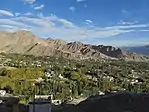 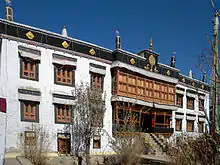 .jpg.webp) 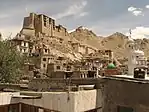   From the top clockwise: Leh city aerial view, Sankar Monastery, Leh Palace, Old city, Shanti Stupa, Spring in Leh | |
Interactive map of Leh | |
| Coordinates: 34°09′51″N 77°35′05″E | |
| Administering country | India |
| Region of administration | Union Territory of Ladakh |
| District | Leh |
| Government | |
| • Type | Ladakh Autonomous Hill Development Council, Leh |
| Area | |
| • Total | 9.15 km2 (3.53 sq mi) |
| Elevation | 3,500 m (11,500 ft) |
| Population (2011) | |
| • Total | 30,870 |
| • Density | 3,400/km2 (8,700/sq mi) |
| Demographics | |
| • Languages | Ladakhi, Balti, Hindi, English[1] |
| Time zone | UTC+5:30 (IST) |
| Vehicle registration | LA 02 |
| Website | leh |
History
.jpeg.webp)
Leh was for centuries an important stopover on trade routes along the Indus Valley between Tibet, Kashmir, India and China. The main goods carried were salt, grain, pashm or cashmere wool, charas or cannabis resin from the Tarim Basin, indigo, silk yarn and Banaras brocade.
Although there are a few indications that the Chinese knew of a trade route through Ladakh to India as early as the Kushan period (1st to 3rd centuries CE),[6] and certainly by the Tang dynasty,[7] little is actually known of the history of the region before the end of the 10th century, when Tibetan prince Skyid lde nyima gon (or Nyima gon), a grandson of the anti-Buddhist Tibetan king, Langdarma (r. c. 838 to 841), founded the kingdom. He conquered Western Tibet, although his army originally numbered only 300 men. Several towns and castles are said to have been founded by Nyima gon, and he apparently ordered the construction of the primary sculptures at Shey. "In an inscription, he says he had them made for the religious benefit of the Tsanpo (the dynastical name of his father and ancestors), and of all the people of Ngaris (Western Tibet). This shows that already in this generation Langdarma's opposition to Buddhism had disappeared."[8] Shey, 15 km east of modern Leh, was the ancient seat of the Ladakhi kings.
During the reign of Delegs Namgyal (1660–1685),[9] the nawab of Kashmir, then a province in the Mughal Empire, arranged for the Mongol army to temporarily leave Ladakh, though it returned later. As payment for assisting Delegs Namgyal in the Tibet-Ladakh-Mughal War of 1679–1684, the nawab made a number of onerous demands. One of the least was construction of a large Sunni Muslim mosque in Leh, at the upper end of the bazaar in Leh below Leh Palace. The mosque reflects a mixture of Islamic and Tibetan architecture and can accommodate more than 500 people. This was apparently not the first mosque in Leh; there are two smaller ones that are said to be older.[10]
Trade routes have traditionally converged on Leh from all four directions. The modern highway follows the most direct route from the Punjab via Mandi, the Kulu valley, the Rohtang Pass, and Lahaul to the Indus Valley, then downriver to Leh. The route from Srinagar was roughly the same as the road that today crosses the Zoji La (pass) to Kargil, then up the Indus Valley to Leh. From Baltistan there were two difficult routes: the main one ran up the Shyok Valley from the Indus, over a pass and then down the Hanu River to the Indus again below Khalsi (Khalatse). The other ran from Skardu straight up the Indus to Kargil and on to Leh. Both summer and winter routes ran from Leh to Yarkand via the Karakoram Pass and Xaidulla. A couple of possible routes also ran from Leh to Lhasa.[11]
The first recorded royal residence in Ladakh, built at the top of the high Namgyal ('Victory') Peak overlooking the present palace and town, is the now-ruined fort and gon-khang (Temple of the Guardian Divinities) built by King Tashi Namgyal. Tashi Namgyal ruled in the final quarter of the 16th century CE.[12] The Namgyal (also called "Tsemo Gompa" (Red Gompa), or dGon-pa-so-ma (New Monastery),[13] a temple, is the main Buddhist centre in Leh.[14] There are some older walls of fortifications behind it which Francke reported were once known as the "Dard Castle." If it was indeed built by Dards, it must pre-date the establishment of Tibetan rulers in Ladakh over a thousand years ago.[15]
The Sankar Labrang (Bsam dkar bla brang) is a small, two-storeyed building owned by Sankar monastery. Sankar monastery is the seat of Bakula Rinpoche, immediately to the northwest of Leh. The monastery's Labrang building is located in the old town of Leh, in the Manikhang neighbourhood. Manikhang is the area between the main bazaar of Leh and the historic Stalam path that leads up to the royal palace. Four huge stūpas standing at this point mark the beginning of historic Leh. In recent memory, the Sankar Labrang had a metalsmith's workshop downstairs, while upstairs lived the monk caretaker of the White Maitreya Temple (Byams khang dkar po), also known locally as "Street Maitreya". The White Maitreya Temple dates back to the reign of King Drakpa Bumd´e (Grags pa 'bum lde, r. ca 1410–1435), following the arrival of a mission sent to Ladakh by the Tibetan lama Tsongkhapa.[16]
Below this are the Chamba (Byams-pa, i.e., Maitreya) and Chenresi (sPyan-ras-gzigs, i.e. Avalokiteshvara) monasteries which are of uncertain date.[13]
Leh Palace
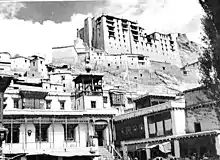
The royal palace, known as Leh Palace, was built by King Sengge Namgyal (1612–1642),[17] presumably between the period when the Portuguese Jesuit priest Francisco de Azevedo visited Leh in 1631, and made no mention of it, and Sengge Namgyal's death in 1642.[18]
The Leh Palace is nine storeys high; the upper floors accommodated the royal family, and the stables and storerooms are located on the lower floors. The palace was abandoned when Kashmiri forces besieged it in the mid-19th century. The royal family moved their premises south to their current home in Stok Palace on the southern bank of the Indus River.
- As has already been mentioned, the original name of the town was not sLel, as it is nowadays spelled, but sLes, which signifies an "encampment of nomads". These [Tibetan] nomads probably visited the Leh valley at when it began to be irrigated by Dard colonisers. The most ancient part of the ruins, atop rNam-rgyal-rtse-mo hill, are called 'aBrog-pal-mkhar (Dard castle).[19]
In 2010, Leh was heavily damaged by the sudden floods caused by a cloud burst.
Administration
The Ladakh Autonomous Hill Development Council (LAHDC) is in charge of governance in Leh.
It has 30 councillors, 4 nominated and 26 elected. The Chief Executive Councillor heads and chairs this council. The Deputy Commissioner of Leh also holds the power of Chief Executive Officer of the LAHDC. The current Deputy Commissioner of Leh district is Santosh Sukhdeve.
Leh Old Town
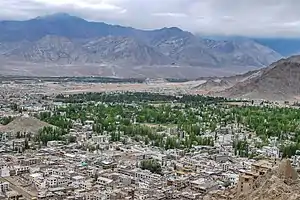
The old town of Leh was added to the World Monuments Fund's list of 100 most endangered sites due to increased rainfall, due to climate change among other reasons.[20] Neglect and changing settlement patterns in the old town have also threatened the long-term preservation of the site.[21]
The rapid and poorly planned urbanisation of Leh has increased the risk of flash floods in some areas, while other areas, according to research by the Climate and Development Knowledge Network, suffer from the less dramatic, gradual effects of 'invisible disasters', which often go unreported.[22]
Geography
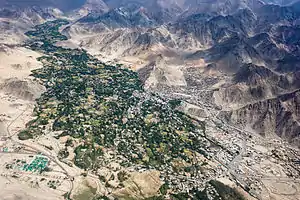
The city is located on the bank of the Indus River. The mountains dominate the landscape around the Leh, as it is at an altitude of 3,500m. Peaks such as Nanga Sago can reach well above 5,500m. The principal access roads include the 434 km Srinagar-Leh highway and the 428 km Leh-Manali Highway. Both roads are only open on a seasonal basis.[23] Although the roads from Srinagar and Manali are often blocked by snow in winter, the local roads in the Indus Valley usually remain open due to the low levels of snowfall.
Climate
| Leh | ||||||||||||||||||||||||||||||||||||||||||||||||||||||||||||
|---|---|---|---|---|---|---|---|---|---|---|---|---|---|---|---|---|---|---|---|---|---|---|---|---|---|---|---|---|---|---|---|---|---|---|---|---|---|---|---|---|---|---|---|---|---|---|---|---|---|---|---|---|---|---|---|---|---|---|---|---|
| Climate chart (explanation) | ||||||||||||||||||||||||||||||||||||||||||||||||||||||||||||
| ||||||||||||||||||||||||||||||||||||||||||||||||||||||||||||
| ||||||||||||||||||||||||||||||||||||||||||||||||||||||||||||
Leh has a cold desert climate (Köppen climate classification BWk) with long, cold winters from late November to early March, with minimum temperatures well below freezing for most of the winter. The city gets occasional snowfall during winter, which is very cold by Indian standards, mainly due to its high elevation. The weather in the remaining months is generally fine and warm during the day. Average annual rainfall is only 35 mm (1.37 inches). In 2010, the city experienced flash floods that killed more than 100 people.[25]
| Climate data for Leh, India (1991-2020 normals, extremes 1883-2020) | |||||||||||||
|---|---|---|---|---|---|---|---|---|---|---|---|---|---|
| Month | Jan | Feb | Mar | Apr | May | Jun | Jul | Aug | Sep | Oct | Nov | Dec | Year |
| Record high °C (°F) | 9.0 (48.2) |
13.4 (56.1) |
19.4 (66.9) |
23.9 (75.0) |
28.9 (84.0) |
34.8 (94.6) |
36.6 (97.9) |
35.4 (95.7) |
31.8 (89.2) |
27.0 (80.6) |
20.0 (68.0) |
13.6 (56.5) |
36.6 (97.9) |
| Average high °C (°F) | 1.5 (34.7) |
4.2 (39.6) |
9.7 (49.5) |
15.3 (59.5) |
20.0 (68.0) |
24.4 (75.9) |
28.5 (83.3) |
28.1 (82.6) |
23.4 (74.1) |
16.7 (62.1) |
10.6 (51.1) |
4.5 (40.1) |
15.6 (60.0) |
| Daily mean °C (°F) | −5.8 (21.6) |
−2.5 (27.5) |
3.0 (37.4) |
8.5 (47.3) |
13.1 (55.6) |
17.9 (64.2) |
22.2 (72.0) |
21.6 (70.9) |
16.3 (61.3) |
8.5 (47.3) |
1.7 (35.1) |
−3.6 (25.5) |
8.4 (47.1) |
| Average low °C (°F) | −13.1 (8.4) |
−9.2 (15.4) |
−3.7 (25.3) |
1.6 (34.9) |
6.2 (43.2) |
11.3 (52.3) |
15.9 (60.6) |
15.1 (59.2) |
9.2 (48.6) |
0.3 (32.5) |
−7.2 (19.0) |
−11.7 (10.9) |
1.2 (34.2) |
| Record low °C (°F) | −28.3 (−18.9) |
−28.6 (−19.5) |
−19.4 (−2.9) |
−12.8 (9.0) |
−7.7 (18.1) |
−1.1 (30.0) |
0.6 (33.1) |
1.5 (34.7) |
−4.4 (24.1) |
−9.6 (14.7) |
−18.6 (−1.5) |
−25.6 (−14.1) |
−28.6 (−19.5) |
| Average rainfall mm (inches) | 4.3 (0.17) |
2.5 (0.10) |
1.5 (0.06) |
1.7 (0.07) |
0.6 (0.02) |
2.9 (0.11) |
6.8 (0.27) |
6.2 (0.24) |
4.4 (0.17) |
2.3 (0.09) |
0.7 (0.03) |
1.0 (0.04) |
34.8 (1.37) |
| Average precipitation days (≥ 0.3 mm) | 1.4 | 1.2 | 0.9 | 1.1 | 0.6 | 1.5 | 1.9 | 2.2 | 1.6 | 0.3 | 0.3 | 0.4 | 13.4 |
| Average relative humidity (%) (at 17:30 IST) | 51 | 51 | 46 | 36 | 30 | 26 | 33 | 34 | 31 | 27 | 40 | 46 | 38 |
| Source: India Meteorological Department (humidity 1951-1980)[26][27] | |||||||||||||
Agriculture
.jpg.webp)
Leh is located at an average elevation of about 3500 metres, which means that only one crop a year can be grown there, while two can be grown at Khalatse. By the time crops are being sown at Leh in late May, they are already half-grown at Khalatse. The main crop is grim (naked barley, Hordeum vulgare L. var. nudum Hook. f., an ancient form of domesticated barley with an easier-to-remove hull. Tsampa, the staple food in Ladakh, is made from this barley.[28] The water for agriculture of Ladakh comes from the Indus, which runs low in March and April when barley-fields have the greatest need for irrigation.[29] Grapes, apricots, currants, walnuts, and apples are also grown in the arid temperate climate.[30]
Demographics
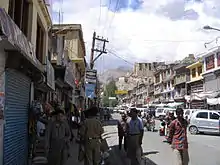
As of the 2011 India census,[31] Lehhad a population of 30,870. Males constituted 70% of the population and females 30%, due to a large presence of transient labourers, traders and government employees. The child sex ratio was 987. Leh had an average literacy rate of 90%, higher than the national average of 74.04%; male literacy was 94.89%, and female literacy was 78.85%. In Leh, 5.5% of the population was under 6 years of age. The people of Leh are ethnic Tibetans who speak Ladakhi, a Tibetic language.
The Muslim presence dates back to the annexation of Ladakh by Kashmir, after the Fifth Dalai Lama came to Ladakh from Tibet. Since then, there has been further migration from the Kashmir Valley, due to trade and recently to the transfer of tourism from the Kashmir Valley to Ladakh.
Ladakh receives very large numbers of tourists for its size. In 2010, 77,800 tourists visited Leh. Visitor numbers have swelled rapidly in recent years, increasing 77% from 2005 to 2010. This growth is largely caused by an increase in domestic Indian travellers.[32]
Religion
Buddhism is the largest religion in Leh, followed by over 43.8% of people. Hinduism is the second-largest religion with 35.4% adherents. Islam and Sikhism form 15.14% and 2.7% of the population respectively.[33]
Since the 8th century, people of different religions, particularly Buddhism and Islam, have lived in Leh. They co-inhabited the region from the early Namgyal dynasty and there are no records of any conflict between them. Meer Izzut-oollah wrote in the early 19th century:
This mosque was built by Ibraheem Khan (in the mid 17th century), who was a man of noble family in the service of the descendants of Timoor. In his time the Kalimaks (Calmuck Tartars), having invaded and obtained possession of the greater portion of Thibet [Ladakh], the Raja of that country claimed protection from the Emperor of Hindoostan. Ibraheem Khan was accordingly deputed by that monarch to his assistance, and in a short time succeeded in expelling the invaders and placing the Raja once more on his throne. The Raja embraced the Mahomedan faith, and formally acknowledged himself as a feudatory of the Emperor, who honored him with the title of Raja Akibut Muhmood Khan, which title to the present day is borne by the Ruler of Cashmere.[34]
In recent times, Muslim migration to Leh from neighbouring Kargil and Kashmir has increased due to better opportunities, and relations between the Buddhist and Muslim communities have soured due to socio-political conflicts.[35]
Other religions such as Christianity, Hinduism and Sikhism do exist in Leh. The small Christian community in Leh descend from Tibetan Buddhists converted by German Moravian missionaries, who established a church at Keylong in Lahaul in the 1860s, and were allowed to open another mission in Leh in 1885 and had a sub-branch in Khalatse. They stayed until Indian Independence in 1947. In spite of their successful medical and educational activities, they were able to make only a few converts.[36]
Every year Sindhu Darshan Festival is held at Shey, 15 km from town, to promote religious harmony and the glory of the Sindhu river. Many tourists come to Leh for this.[37]
Attractions
In Leh
- Leh Palace
- Namgyal Tsemo Gompa
- Shanti Stupa
- Cho Khang Gompa
- Chamba Temple
- Jama Masjid
- Gurdwara Pathar Sahib
- Sankar Gompa and village
- War Museum
- The Victory Tower
- Zorawar Fort
- Ladakh Marathon
- Datun Sahib
- Ice Stupa
 Leh Palace View from Leh Market
Leh Palace View from Leh Market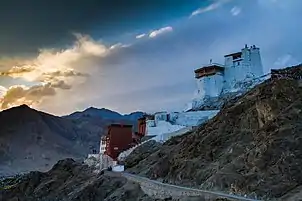
.jpg.webp)
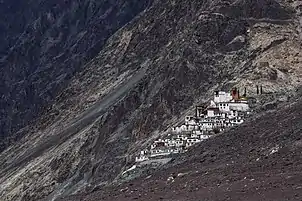
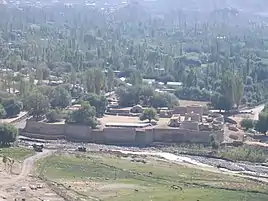

Transportation

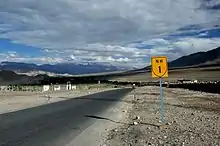
Road
Leh is connected to the rest of India by two high-altitude roads, both of which are subject to landslides and impassable in winter due to snows. The National Highway 1 from Srinagar via Kargil is generally open longer. The Leh-Manali Highway can be troublesome due to very high passes and plateaus. A third road is under construction.
The overland approach to Ladakh from the Kashmir valley via the 434-km. National Highway 1 typically remains open for traffic from April/May to October/November. The most dramatic part of this journey is the ascent up the 3,505-metre-high (11,499 ft) Zoji-la, a tortuous pass in the Great Himalayan Wall. The Jammu and Kashmir State Road Transport Corporation (JKSRTC) operates regular deluxe and ordinary bus services between Srinagar and Leh on this route, with an overnight halt at Kargil. Taxis (cars and jeeps) are also available at Srinagar for the journey.
Since 1989, the 473-kilometre-long (294 mi) Leh-Manali Highway has served as the second land approach to Ladakh. Open from June to late October, this high road traverses the upland desert plateaux of Rupsho, whose altitude ranges from 3,660 m (12,010 ft) to 4,570 m (14,990 ft). There are a number of high passes en route among which the highest one, known as Tanglang La, is sometimes incorrectly claimed to be the world's second-highest motorable pass at an altitude of 5,325 metres (17,470 ft)[38]
This third road to Leh is currently under construction.
Air
Leh Kushok Bakula Rimpochee Airport has flights to and fro Delhi, Jammu, Srinagar and Chandigarh. Air India, Go First, IndiGo & Vistara operate Delhi to Leh daily with multiple flights at peak times.
Rail
There is currently no railway service in Ladakh, however two railway routes are proposed: the Bhanupli–Leh line and Srinagar–Kargil–Leh line.[39],
Banking facilities
List of functioning banks in Leh
Media and communications
State-owned All India Radio Leh has a local station in Leh, which transmits various programs of mass interest. Leh head post office owned by India Post also serves as a major means of communications. On 14 December 2021, the first FM radio station in Ladakh was established in Leh.[43]
Footnotes
- Zutshi, Chitralekha (2004). Languages of Belonging: Islam, Regional Identity, and the Making of Kashmir. Hurst & Company. ISBN 978-1-85065-694-4.
- "Definition of LEH". www.merriam-webster.com. Retrieved 28 January 2023.
- The application of the term "administered" to the various regions of Kashmir and a mention of the Kashmir dispute is supported by the tertiary sources (a) through (e), reflecting due weight in the coverage. Although "controlled" and "held" are also applied neutrally to the names of the disputants or to the regions administered by them, as evidenced in sources (h) through (i) below, "held" is also considered politicized usage, as is the term "occupied," (see (j) below).
(a) Kashmir, region Indian subcontinent, Encyclopaedia Britannica, retrieved 15 August 2019 (subscription required) Quote: "Kashmir, region of the northwestern Indian subcontinent ... has been the subject of dispute between India and Pakistan since the partition of the Indian subcontinent in 1947. The northern and western portions are administered by Pakistan and comprise three areas: Azad Kashmir, Gilgit, and Baltistan, the last two being part of a territory called the Northern Areas. Administered by India are the southern and southeastern portions, which constitute the state of Jammu and Kashmir but are slated to be split into two union territories.";
(b) Pletcher, Kenneth, Aksai Chin, Plateau Region, Asia, Encyclopaedia Britannica, retrieved 16 August 2019 (subscription required) Quote: "Aksai Chin, Chinese (Pinyin) Aksayqin, portion of the Kashmir region, at the northernmost extent of the Indian subcontinent in south-central Asia. It constitutes nearly all the territory of the Chinese-administered sector of Kashmir that is claimed by India to be part of the Ladakh area of Jammu and Kashmir state.";
(c) "Kashmir", Encyclopedia Americana, Scholastic Library Publishing, 2006, p. 328, ISBN 978-0-7172-0139-6 C. E Bosworth, University of Manchester Quote: "KASHMIR, kash'mer, the northernmost region of the Indian subcontinent, administered partlv by India, partly by Pakistan, and partly by China. The region has been the subject of a bitter dispute between India and Pakistan since they became independent in 1947";
(d) Osmańczyk, Edmund Jan (2003), Encyclopedia of the United Nations and International Agreements: G to M, Taylor & Francis, pp. 1191–, ISBN 978-0-415-93922-5 Quote: "Jammu and Kashmir: Territory in northwestern India, subject to a dispute between India and Pakistan. It has borders with Pakistan and China."
(e) Talbot, Ian (2016), A History of Modern South Asia: Politics, States, Diasporas, Yale University Press, pp. 28–29, ISBN 978-0-300-19694-8 Quote: "We move from a disputed international border to a dotted line on the map that represents a military border not recognized in international law. The line of control separates the Indian and Pakistani administered areas of the former Princely State of Jammu and Kashmir.";
(f) Skutsch, Carl (2015) [2007], "China: Border War with India, 1962", in Ciment, James (ed.), Encyclopedia of Conflicts Since World War II (2nd ed.), London and New York: Routledge, p. 573, ISBN 978-0-7656-8005-1,The situation between the two nations was complicated by the 1957–1959 uprising by Tibetans against Chinese rule. Refugees poured across the Indian border, and the Indian public was outraged. Any compromise with China on the border issue became impossible. Similarly, China was offended that India had given political asylum to the Dalai Lama when he fled across the border in March 1959. In late 1959, there were shots fired between border patrols operating along both the ill-defined McMahon Line and in the Aksai Chin.
(g) Clary, Christopher, The Difficult Politics of Peace: Rivalry in Modern South Asia, Oxford and New York: Oxford University Press, p. 109, ISBN 9780197638408,Territorial Dispute: The situation along the Sino-Indian frontier continued to worsen. In late July (1959), an Indian reconnaissance patrol was blocked, "apprehended," and eventually expelled after three weeks in custody at the hands of a larger Chinese force near Khurnak Fort in Aksai Chin. ... Circumstances worsened further in October 1959, when a major class at Kongka Pass in eastern Ladakh led to nine dead and ten captured Indian border personnel, making it by far the most serious Sino-Indian class since India's independence.
(h) Bose, Sumantra (2009), Kashmir: Roots of Conflict, Paths to Peace, Harvard University Press, pp. 294, 291, 293, ISBN 978-0-674-02855-5 Quote: "J&K: Jammu and Kashmir. The former princely state that is the subject of the Kashmir dispute. Besides IJK (Indian-controlled Jammu and Kashmir. The larger and more populous part of the former princely state. It has a population of slightly over 10 million, and comprises three regions: Kashmir Valley, Jammu, and Ladakh.) and AJK ('Azad" (Free) Jammu and Kashmir. The more populous part of Pakistani-controlled J&K, with a population of approximately 2.5 million.), it includes the sparsely populated "Northern Areas" of Gilgit and Baltistan, remote mountainous regions which are directly administered, unlike AJK, by the Pakistani central authorities, and some high-altitude uninhabitable tracts under Chinese control."
(i) Fisher, Michael H. (2018), An Environmental History of India: From Earliest Times to the Twenty-First Century, Cambridge University Press, p. 166, ISBN 978-1-107-11162-2 Quote: "Kashmir's identity remains hotly disputed with a UN-supervised “Line of Control” still separating Pakistani-held Azad (“Free”) Kashmir from Indian-held Kashmir.";
(j) Snedden, Christopher (2015), Understanding Kashmir and Kashmiris, Oxford University Press, p. 10, ISBN 978-1-84904-621-3 Quote:"Some politicised terms also are used to describe parts of J&K. These terms include the words 'occupied' and 'held'." - "Ladakh", Encyclopaedia Britannica, Encyclopædia Britannica, 1 March 2021, archived from the original on 7 April 2022, retrieved 2 April 2022,
Ladakh, large area of the northern and eastern Kashmir region, northwestern Indian subcontinent. Administratively, Ladakh is divided between Pakistan (northwest), as part of Gilgit-Baltistan, and India (southeast), as part of Ladakh union territory (until October 31, 2019, part of Jammu and Kashmir state); in addition, China administers portions of northeastern Ladakh.
- explorer, the india. "TOP Places of Visit in Leh Ladakh (2023)". the india explorer. nishi. Retrieved 30 May 2023.
- Hill (2009), pp. 200-204.
- Francke (1977 edition), pp. 76-78
- Francke (1914), pp. 89-90.
- Francke (1977 edition), p. 20.
- Francke (1977 edition), pp. 120-123.
- Rizvi (1996), pp. 109-111.
- Rizvi (1996), p. 64.
- Francke (1914), p. 70.
- Rizvi (1996), pp. 41, 64, 225-226.
- Rizvi (1996), pp. 226-227.
- Alexander, André, and Van Shaik, Sam. (2011). The Stone Maitreya of Leh: The Rediscovery and Recovery of an Early Tibetan Monument.. JRAS, Series 3, 21, 4(2011), p. 421.
- "Incredible India | Leh Palace". incredibleindia.org. Retrieved 16 October 2021.
- Rizvi (1996), pp. 69, 290.
- Francke (1914), p. 68. See also, ibid, p. 45.
- "Tourist Boom Brings Threat to Leh's Tibetan Architecture". AFP. 19 August 2007.
- Tripti Lahiri (23 August 2007). "Ethnic Leh Houses Falling Apart". AFP. Archived from the original on 6 July 2008.
- Local approaches to harmonising climate adaptation and disaster risk reduction: Lessons from India, Anshu Sharma, Sahba Chauhan and Sunny Kumar, the Climate and Development Knowledge Network, 2014 Archived 7 July 2014 at the Wayback Machine cdkn.org
- "jktourism.org". www.jktourism.org.
- "Leh". Archived from the original on 25 February 2018. Retrieved 16 August 2017.
- Polgreen, Lydia (6 August 2010). "Mudslides Kill 125 in Kashmir". The New York Times. Retrieved 6 August 2010.
- "Climatological Normals 1991-2020" (PDF). India Meteorological Department. Retrieved 25 February 2023.
- "Leh Climatological Table Period: 1951–1980". India Meteorological Department. Archived from the original on 21 July 2011. Retrieved 4 April 2020.
- Rizvi (1996), p. 38.
- "Jammu & Kashmir – Geography & Geology". Peace kashmir. Archived from the original on 9 August 2016. Retrieved 28 July 2015.
- Rashid, Abdul; Sultan, Farah (2021). Know Your State Jammu and Kashmir and Ladakh. Arihant Publications India. ISBN 978-93-257-9092-6.
- "District Census Handbook Leh (Ladakh)" (PDF). Census of India 2011. Directorate of Census Operations (Jammu & Kashmir). pp. 112–113.
- "History" (PDF). Archived from the original (PDF) on 24 July 2013. Retrieved 18 May 2012.
- "Leh City Population". Census India. Retrieved 26 June 2021.
- Travels in Central Asia by Meer Izzut-oollah in the Years 1812-13. Translated by Captain Henderson. Calcutta, 1872, p. 12.
- "Why Buddhist women are marrying Muslim men in Ladakh". Business Standard India. 15 September 2017.
- Rizvi (1996), p. 212.
- "Sindhu Darshan Festival". Archived from the original on 30 September 2020. Retrieved 22 January 2011.
- Khardung La for a discussion of the world's highest motorable passes.
- "How to Reach Leh". The Indian Backpacker. December 2012. Retrieved 2 January 2013.
- "HDFC BANK LEH Branch IFSC Code, MICR Code, Address & Phone Number". The Economic Times.
- "AXIS BANK LEH LADAKH Branch IFSC Code, MICR Code, Address & Phone Number". The Economic Times.
- "IDBI BANK LTD, Leh Branch, Ladakh, Jammu & Kashmir, BankIFSCcode.com". bankifsccode.com.
- "Ladakh gets its first-ever FM radio station". The Indian Express. 14 December 2021. Retrieved 15 December 2021.
References
- Alexander, André, and Van Shaik, Sam. (2011). The Stone Maitreya of Leh: The Rediscovery and Recovery of an Early Tibetan Monument.. JRAS, Series 3, 21, 4(2011), pp. 421–439.
- Janet Rizvi. Ladakh: Crossroads of High Asia. Second Edition. (1996). Oxford University Press, Delhi. ISBN 978-0-19-564546-0.
- Cunningham, Alexander. (1854). LADĀK: Physical, Statistical, and Historical with Notices of the Surrounding Countries. London. Reprint: Sagar Publications (1977).
- Francke, A. H. (1977). A History of Ladakh. (Originally published as, A History of Western Tibet, (1907)). 1977 Edition with critical introduction and annotations by S. S. Gergan & F. M. Hassnain. Sterling Publishers, New Delhi.
- Francke, A. H. (1914). Antiquities of Indian Tibet. Two Volumes. Calcutta. 1972 reprint: S. Chand, New Delhi.
- Hilary Keating (July–August 1993). "The Road to Leh". Saudi Aramco World. Houston, Texas: Aramco Services Company. 44 (4): 8–17. ISSN 1530-5821. Archived from the original on 28 September 2012. Retrieved 29 June 2009.

